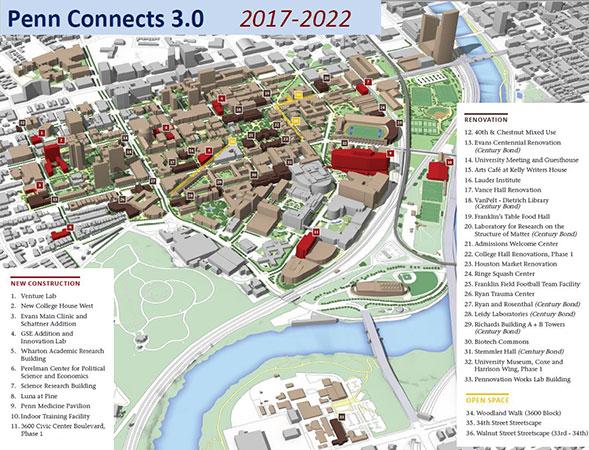Campus Plan

Penn Connects 3.0 | Penn Connects 2.0 | Penn Connects (2006)
Penn Connects - Our Transformative Campus Plan
For additional information, visit the Penn Connects website.
In 2006, we set out to transform the University of Pennsylvania campus. We called our vision for the future Penn Connects, because we were intent on creating the most vibrant, sustainable and innovative urban university that's deeply connected to our local community with far-reaching global perspectives. Signature phase one projects such as Penn Park, the Singh Center for Nanotechnology and the Lauder College House capture the spirit of new green spaces, reinvented campus gateways, and enriched environments for academic and research initiatives.
Penn Connects 2.0 and 3.0 continued our investment in Penn's historic West Philadelphia campus, while boldly creating a new tech-transfer ecosystem at the Pennovation Works. With the opening of the Penn Biden Center for Diplomacy and Global Engagement and the Penn Wharton China Center, Penn’s leadership in global affairs extended beyond Philadelphia to Washington D.C. and Beijing.
Since 2006, Penn, Penn Medicine and our development partners have collectively realized 8.6 million square feet of new construction and reinvested in 3.7 million square feet of renovated space, while also adding over 30 acres of new open space. These capital achievements represent a combined public and private investment of $7 billion.
The vision for Penn Connects 3.1 continues the transformation of our award-winning urban campus, supporting all aspects of Penn's teaching and scholarship, research, and clinical care while enriching our students' living and learning experiences, strengthening community engagement, and advancing sustainable leadership.
View the publication, Penn Connects 3.0 Realizing the Vision (PDF sections below)
Penn Connects 2.0: A Vision for the Future
Penn Connects: A Vision for the Future set out an exciting blueprint for the Penn campus. This 2006 plan was a direct response to the Penn Compact and the campus-wide opportunities presented by the acquisition of the former US Post Office Building at 30th and Market Streets, the Post Office Annex, and 14 acres of land along the Schuylkill River. It provided clear recommendations for incorporating these postal acquisitions into the campus, establishing a major physical presence for Penn along the Schuylkill River, and for creating new connections between the campus and Center City.
Since 2006, Penn has completed nearly all of the projects set out as part of the Phase 1 implementation plan, resulting in a far-reaching, positive impact on the campus and community beyond. The renewed vision of Penn Connects 2.0 builds upon the accomplishments of Phase 1 and the acquisition of a 23-acre former industrial parcel located at 3401 Grays Ferry Avenue, just south of campus along the Schuylkill River, now known as Pennovation Works. Penn Connects 2.0 enhances and reinforces the planning and design vision for the campus in response to emerging sustainability goals.
Penn Connects (2006)
Penn Connects was an inspiring and achievable vision for the future of the entire campus and, in particular, the new and existing land in the east. It set forth a vision rooted in the tradition and history of the campus. A vision that extends and enhances the successes of previous planning and design initiatives. A vision that has transformed the campus, such as the creation of Locust and Woodland Walks and Blanche Levy Park.
The Plan recommended creating civic and open space; identifying land use and development zones; and improving physical connections for pedestrians, automobiles, and bicycles.